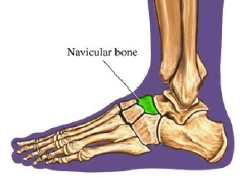
Köhler’s disease is a rare bone disorder affecting the foot in children between 6 to 9 years of age. The disease typically affects males, but it can affect females as well.
The usual symptoms are pain and swelling in the middle of the foot. A limp may also be present.
Köhler’s Disease occurs at the navicular bone in the foot (see diagram below).

Köhler’s Disease is caused when the navicular bone temporarily loses its blood supply. As a result of this blood loss, the tissue in the bone dies and the bone collapses. When treated properly, there are no long term side affects. Symptoms typically resolve over time as the navicular bone revascularizes.
Köhler’s Disease is thought to be caused from the result of an abnormal stress acting on a weak, un-ossified navicular bone. Ossification refers to the hardening of bone or bone formation in the carti-lage model of the fully grown bone seen in child-hood. In boys, ossification typically takes place around 24-30 months and in girls it takes place around 18-24 months.
As children learn to walk and grow, more weight is put on the foot. If the navicular bone ossifies slow-er than the rest of the surrounding bones in the foot, then those bones may compress the navicu-lar bone and its blood vessels, causing it to lose its blood supply.
Treatment for Köhler’s disease includes anti-inflammatory medication (as directed by the doctor), resting the affected foot, and occasionally cast application. Moderate exercise or stretching and physical therapy may also help. There are rarely any complications and symptoms generally resolve within 2 years.
Taking anti-inflammatory medicine or NSAIDS (non-steroidal anti-inflammatory drugs) such as Motrin, Advil, Naproxen or Aleve as directed by your doctor can be effective. This medication should be taken for 10 to 14 days to allow the medicine to build up therapeutic levels in the body. Taking the medication infrequently allows the medicine levels to drop, which decreases effectiveness.
A short leg cast (cast below the knee) is usually worn for 3 to 6 weeks. After the cast is taken off, some patients are prescribed arch supports or custom braces which fit into their shoes.

Your doctor diagnosis Köhler’s disease based on your symptoms, clinical examination, and x-rays. An MRI may be ordered by your doctor to confirm the diagnosis or to exclude other problems.
No. There is no way to prevent a child from developing Köhler’s disease. However, it is relatively uncommon.